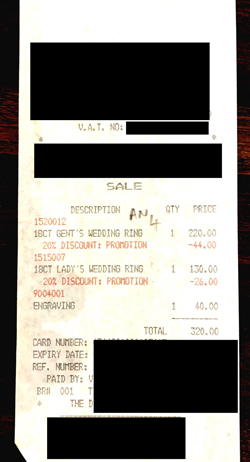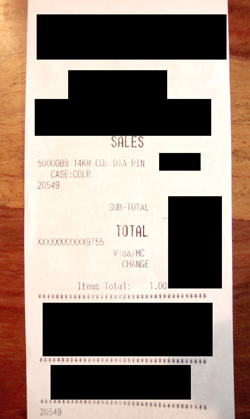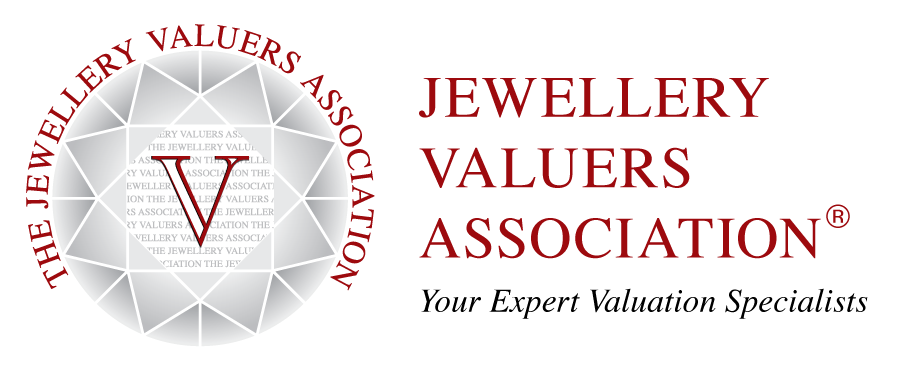Gareth Brown FGA DGA FJVA
The question of, 'why do I need a valuation, when I have the receipt' is a common one that I encounter. And on the face of it, it's a fair one to ask. It makes sense to wonder why you'd need a valuation, especially for something you may have only recently purchased. But the key is to understand what a receipt is and ultimately what it is not. The sole purpose of a receipt is to record pertinent information relating to a specific transaction. It records information relating to the item or items purchased, the 'asking' price, any applicable discounts or taxes, the total amount paid, and the payment method.
In short, it shows what the seller was prepared to sell the item for and what a buyer was prepared to pay for it. The factors that influence both parties regarding whether they need to buy or sell are numerous and varied. Often, the conditions that lead to the transaction being completed might never be duplicated again. Which is why a receipt shows the price paid and not a value.
So as a record of a transaction, a receipt is fantastic. Sadly, receipts just aren't designed to provide the required information that you'll need to obtain sufficient insurance cover or justify an amount for a claim's settlement. Of course, there are exceptions to this rule, such as easily quantifiable items, like brown and white goods. In these instances, the receipt will often show the items model number, such as, Sony BRAVIA TV KD65XH9005BU, which makes it straightforward for the insurance company to quantify the cover or settlement level. Solely because this TV model will be the same wherever you buy it. The same goes for your washing machine, dishwasher or fridge freezer.
Jewellery, on the other hand, is a different proposition entirely. But why? Unlike companies who sell electrical goods or kitchen appliances, all of which come from a small number of well-known manufacturers. UK jewellers can buy from a vast global network of manufacturers, importers, and suppliers. Various production methods are used to manufacture jewellery, all of which have varying degrees of cost. The majority of all jewellery is produced in precious metals, a notoriously sensitive market financially, where the price you pay today will most likely not be what you will have to pay tomorrow.
Jewellery can also contain a vast array of different gemstones, all varying in shape, size, quality and ultimately cost. Diamonds are equally complex and have 'list' prices that vary depending upon the stone's shape, size, and quality. These 'list prices' fluctuate based on availability and market demand for particular stones, and it is these lists that diamond dealers use to decide the asking price of the diamond they want to sell. In most cases, their asking prices will be less than the list, but sometimes if a stone of a particular, shape, size or quality is in demand, then the dealers asking price, may well be more than the list price. You can have ten diamond dealers, all selling the same size and specification diamond and all of them will be asking a different price.
Jewellery is complicated even further because everything is paid for in US dollars, so any exchange rate changes will immediately impact the production cost. I could make a diamond ring today and again in three months, using the same specifications and suppliers and each time the production cost will be different as will my asking price for it. And on top of that, each jeweller will sell their items through varying retail platforms, all with different mark-up levels, relevant to each specific business.
For example, a 9 carat yellow gold machine made chain weighing 7.00 grams will cost X in London, Y in Exeter and Z in Newcastle. Therefore, the price you paid does not necessarily reflect the value of the item.

When dealing with jewellery items, it is essential to know what information is lacking from a receipt. So let us take a look at this first receipt (figure 1), which is for two wedding rings. It proves that they were 18 carat gold, it shows the asking price, and how much was paid after discount. However, it does not prove how much these rings weighed or how they were made. Other pertinent facts are missing, but knowing these two points are critical, as the cost of gold has been increasing over many years.
If the rings have been lost or stolen and the information needed isn't on the receipt, what options do you have? Well, you could go back to the original retailer and hope they have kept detailed stock records. But I can tell you from personal experience, that is a long shot at best. So you are left with guesswork, based on the limited information available. But that is a massive ask with variables that will have a monumental impact upon a replacement value.

The second receipt would provide an even more significant challenge (figure 2). From this, we can determine that the item was a 14ct white gold diamond set ring. On this occasion, we do not know how many diamonds the ring is set with, their shape, size and most importantly, their quality. Again we also do not know the weight or method of the manufacture of the ring. Photographs will enable us to determine what the ring looked like aesthetically, but it will not provide any detailed information. And with no way of proving the necessary details, it is impossible to justify a replacement value, over what was initially paid, which could leave you significantly out of pocket.
Imagine if a retailer made or bought in an item and priced it at a time when materials cost less, and they have never updated their retail price. What if they were keen to move it on and gave a substantial discount, or you were just a formidable negotiator. Either way, if you happened to purchase an item of jewellery incredibly well, then what you paid wouldn't be enough to replace it on the day you bought it, let alone a year or two later.
The simple fact is, when it comes to jewellery, there is a myriad of variables, which are critical in determining a replacement value and a receipt is just not designed or able to record them. The only way you can ensure that all the critical facts are recorded is to have your jewellery independently valued. This will enable you to ensure that you have sufficient insurance cover in place and should the worst ever happen, it will help ensure your claim is settled swiftly and successfully.
So now you need your jewellery valued, where do you start? Firstly speak to the Jewellery Valuers Association® (JVA). The JVA is the United Kingdom's leading independent governing body for professional registered valuers. This will give you peace of mind that a registered, qualified, and an experienced valuer has completed your valuation and that it is fit for purpose. Then speak to your insurance provider or broker and ensure that your cover level is up to date and sufficient.
Finally, the cost of jewellery goes up, down and sideways. What you paid is rarely ever reflective of the market as a whole and is often insufficient if you had to replace the item today. Never rely on just a receipt, always ensure you have your jewellery valued, not just once, but every few years, as the market is always changing.
About the Author:
Gareth Brown FGA, DGA, GIA-Pearls, CPAA, AJP, FJVA, is a professional watch and jewellery valuer, and a fellow of The Jewellery Valuers Association. He is also the director of Clarity Valuations Ltd, a specialist company providing independent watch and jewellery valuations to members of the public, jewellery trade, solicitors, insurance companies, and local authorities.
